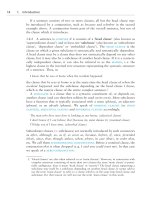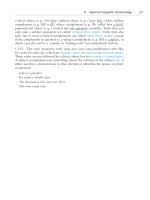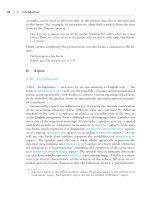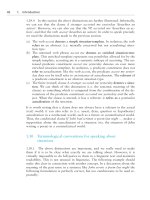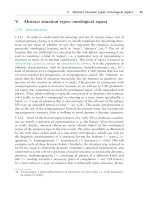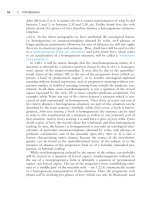The grammar of the english verb phrase part 57 pdf
Bạn đang xem bản rút gọn của tài liệu. Xem và tải ngay bản đầy đủ của tài liệu tại đây (74.03 KB, 7 trang )
III. Arguments for distinguishing between the absolute and the relative past tense 385
This test is corroborated by the fact that it makes the correct predictions in
cases in which the relevant T-relation is T-anteriority rather than T-simultane-
ity:
John expects that he will feel lonely when Mary {has left /*will have left}.
John expected that he would feel lonely when Mary {had left /*would have left}.
Compare also:
[The thought of his case never left him now. He had often considered whether it
would not be better to draw up a written defence and hand it in to the Court.] In
this defence he would give a short account of his life, and when he came to an event
of any importance he would explain for what reasons he had acted as he did, inti-
mate whether he approved or condemned his way of action in retrospect, and adduce
grounds for the condemnation or approval. (TTR) (The past tense forms came, did,
approved and condemned are all relative tense forms expressing T-simultaneity with
the situation time of their head clause. Note that initimate is short for would inti-
mate.)
(…) In this defence he will give a short account of his life, and when he {comes / *will
come} to an event of any importance he will explain for what reasons he has acted as
he has, intimate whether he approves or condemns his way of action in retrospect, and
adduce grounds for the condemnation or approval. (The forms comes, has acted, has,
approves and condemns all express a T-relation in a post-present domain. The present
tense forms all express T-simultaneity with the situation time of their head clause.)
8.23.2 This test rests on the assumption that the possibilities and restrictions
in connection with the use of absolute and relative tense forms in particular
types of clauses are the same in a past domain as they are in a post-present
one. Though the above examples all corroborate this assumption, we have not
yet adduced any really conclusive evidence that the assumption is correct. The
test must therefore provisionally be treated as tentative.
8.24 Argument 2: past tenses whose situation time is
W-posterior to t
0
Unlike the first argument, this argument is a cogent one.
In a sentence like Mary told me on the phone last night that at the dinner party tomor-
row she would suddenly say that she felt sick, the past tense form felt refers to a
situation which lies in the post-present (i. e. which is W-posterior to t
0
). This observa-
tion demonstrates the inadequacy of the assumption that there is only one past tense
386 8. Temporal domains and relative tenses: theoretical foundations
in English, which is used to locate a situation time prior to t
0
. However, the observation
is naturally explained on the assumption that felt is a relative past tense form expressing
T-simultaneity. This constitutes very strong evidence in favour of a theory which as-
sumes the existence of a relative past tense (next to an absolute one), which expresses
T-simultaneity in a past domain, irrespective of the W-location of the binding time
relative to t
0
.
8.24.1 We have argued that the tense structure (ϭ semantics) of the two kinds
of past tense are quite different from each other: the semantics of the absolute
preterite is ‘The situation time establishes a past domain’, while that of the
relative preterite is ‘The situation time is represented as T-simultaneous with a
binding orientation time belonging to a past domain or subdomain (or to a
‘pseudo-past subdomain’ Ϫ see 9.9.1 and 9.18.1)’. Since it is not the existence
of the absolute preterite that is subject to debate, but the existence of the
relative preterite, what we need to show is that there are preterite forms that
unequivocally express the tense structure typical of the relative preterite. In
our opinion, the italicized tense forms of the following examples fulfil this
requirement Ϫ see Figure 8.6:
[A few weeks ago he told us about what he planned to do.] When he was fifty-five
he would retire. [He would move to some place in the south and …].
[Yesterday the Prime Minister repeated that] if the party lost next week’s elections,
this would not induce it to change its views on nuclear energy.
Until a moment ago I thought that at tomorrow’s meeting of the board he would
argue that it was necessary to sell the company. [But he’s just assured me that he
isn’t going to do that.]
Mary told me on the phone last night that at the dinner party tomorrow she would
suddenly say that she felt sick.
Figure 8.6. The tense structure of Mary told me on the phone last night that at the
dinner party tomorrow she would suddenly say that she felt sick.
III. Arguments for distinguishing between the absolute and the relative past tense 387
In these examples, the situations described by was [fifty-five], lost, was [neces-
sary] and felt [sick] are interpreted as W-posterior to t
0
(because of the tempo-
ral indications in the relevant clauses), but this W-posteriority relation is not
expressed by the past tense forms. This means three things. First, the italicized
preterites cannot be analysed as absolute tense forms in any tense theory, be-
cause the absolute preterite,
11
which is the only kind of (nonmodal) preterite
recognized by most tense theories, locates its situation time anterior to t
0
and
is therefore semantically incompatible with an interpretation in which the situ-
ation in question lies completely in the post-present. Secondly, in the above
examples, the italicized preterites not only fail to represent their situation time
as T-anterior to t
0
, they fail to represent it as T-anterior to anything. (This
means that T-anteriority does not form part of their meaning.) Thirdly, al-
though the past tense forms themselves do not express the W-posteriority rela-
tion, they are not incompatible with it. This is in keeping with our analysis of
these forms as being relative preterite forms: these tense forms merely represent
their situation time as T-simultaneous (ϭ coinciding) with a situation time
belonging to a past domain. (The conditional tense represents that T-binding
situation time as T-posterior to the central orientation time of the past do-
main.) Thus, in the third example was [necessary] represents its situation time
as T-simultaneous with the situation time of would argue, which is a situation
time belonging to the set of situation times constituting the temporal domain
established by thought. It should be kept in mind that a tense form representing
its situation time as T-posterior to the central orientation time of a past domain
does not say anything about the W-relation between the relevant situation and
t
0
: as is clear from He said he would do it {yesterday / now / tomorrow}, the
situation referred to by the conditional tense (which represents its situation
time as T-posterior to an orientation time in a past domain) may be interpreted
as W-anterior, W-simultaneous or W-posterior to t
0
. Obviously, the same is
true of any situation whose situation time is represented as T-simultaneous (ϭ
coinciding) with the situation time of a situation referred to in the conditional
tense, as the following example illustrates:
He said he would do it when he had time. [So he may already have done it, or he may
be doing it right now, or he may be going to do it tomorrow. I don’t know which.]
In this example, had is another instance of a past tense form which cannot
possibly be analysed as an absolute preterite, nor as a past tense representing
its situation time as T-anterior to an orientation time other than t
0
, but which
fully satisfies our definition of ‘relative past tense form’ (expressing T-simulta-
11. As noted in 1.14, we use ‘preterite’ to refer to forms like walked, said, went, etc. Other
forms involving the past tense morpheme (such as had walked, would walk, would have
walked) are not preterite forms.
388 8. Temporal domains and relative tenses: theoretical foundations
neity in a past domain). More generally, as is shown by Figure 8.6, a past
domain can contain one or more subdomains which are W-interpreted as lying
in the post-present. A past tense expressing T-simultaneity in such a subdomain
cannot be analysed as an absolute past tense.
The following are some further examples in which the situation time of a
clause in the relative past tense is interpreted as W-posterior to t
0
:
[He told me yesterday that exactly 17 days from now he would tell Mary that] he
was inviting her to lunch because it was his birthday.
[“What was it he told you yesterday?” Ϫ “He said that, inevitably, the time would
come when] he was fed up with working in a factory [and would look out for a
better job.”]
[He said he would read the article tomorrow while] he was in the dentist’s waiting-room.
Here again, the italicized past tense forms not only do not mean ‘past relative
to t
0
’ (as they would do if they were absolute preterites), but do not mean ‘past
relative to (any kind of) orientation time’. The temporal relation they express
is that of T-simultaneity with a situation time belonging to a past temporal
domain (but interpreted as W-posterior to t
0
).
8.24.2 The above data, which are naturally explained if one assumes the exis-
tence of a relative past tense in English (and hence the existence of temporal
domains), cannot possibly be accounted for by an analysis that assumes that
there is only one past tense, expressing that the situation time is past relative
to t
0
. This argument in favour of the existence of a relative preterite is so
cogent that it should be sufficient on its own to discard any analysis denying
the existence of a relative past tense in English.
8.24.3 All the examples given in 8.24.1, and in fact in all the other arguments
that will be presented below, are instances of ‘represented speech’, i. e. indirect
reported speech or free indirect speech (see 8.25.1). This is because represented
speech forms the only context in which the use of the conditional tense (to
express T-posteriority) is natural. Expressing T-posteriority is tantamount to
making a prediction or expressing an expectation, and this can only be done
in an
intensional (opaque)
12
context like represented speech.
13
(A similar
12. An opaque context (or ‘intensional context’) is one in which the reference is not to the
real world but to an alternative (nonfactual) world. Such a context is created by
(amongst other things) ‘intensional verbs’ (‘verbs of propositional attitude’) like want,
expect, believe, think, imagine, etc. Clauses that form part of an intensional context
receive an ‘opaque’ (‘de dicto’) interpretation, i. e. their truth is not evaluated in relation
to the real world but in relation to the alternative world referred to.
Clauses belonging to a nonintensional context receive a ‘transparent’ (‘de re’) inter-
pretation, i. e. their truth is evaluated in relation to the real world. It is typical of such
an interpretation that the truth value of the clause is not affected when a referring
III. Arguments for distinguishing between the absolute and the relative past tense 389
remark can be made in connection with the future tense: reference to the post-
present by itself creates opacity, i. e. a post-present domain is by definition an
opaque domain. Thus, in [If you do that,] you will regret for ever that you
have done it, the ‘doing it’ is not factual in the speaker’s t
0
-world (ϭ the actual
world): it is only factual in the post-present intensional domain, i. e. in a not-
yet-factual alternative world.)
However, the fact that the data are restricted to cases in which T-posteriority
is expressed does not in any way affect the strength of our argument. As
pointed out at the beginning of 8.24.1, all that is necessary to prove the exis-
tence of the relative preterite in English is to adduce examples of preterites that
cannot possibly be analysed as absolute preterites, and a number of such exam-
ples have been given here.
8.24.4 It should also be noted that the examples given in 8.24.1 all have
nonpast counterparts in which the future tense is used instead of the condi-
tional tense in the head clause and in which the present tense is used instead
of the relative past tense in the subclause:
[He has told us about what he plans to do.] When he is fifty-five he will retire. [He
will move to some place in the south and …].
I will read the article tomorrow while I am in the dentist’s waiting-room.
[He says that, inevitably,] the time will come when he is fed up with working in a
factory [and will look out for a better job.]
Exactly 17 days from now I will tell Mary that I am inviting her to lunch because it
is my birthday.
There can be no doubt that the italicized present tense forms in these examples
express T-simultaneity in a post-present domain: these forms cannot be inter-
preted as locating their situation time at t
0
. Since these sentences with the
future tense in the head clause and the present tense in the subclause are the
nonpast counterparts of examples involving the conditional tense in the head
expression in the clause is replaced by an ‘identical’ expression (i. e. by an expression
with the same referent). Thus, since in the real world the capital of France and Paris
have the same referent, we can replace the former by the latter in The capital of France
has ten million inhabitants without altering the truth value of the sentence.
In sentences that receive an opaque interpretation, the replacement of a term by an
‘identical’ expression may affect the truth value: the sentence Bill thinks that Paris is the
capital of Spain may be true even if Bill thinks that the capital of France is the capital
of Spain is not true.
13. We are disregarding here the special use of would in the sense of was to,asinTen years
later Tom {would / was to} be the richest man in town Ϫ see 9.6.7. (This is the only
use in which would is interpreted as referring to a past fact rather than as merely making
a prediction.)
390 8. Temporal domains and relative tenses: theoretical foundations
clause and the past tense in the subclause, it stands to reason that in both cases
the tense in the subclause should be analysed as a tense expressing T-simultane-
ity (coincidence) with a situation time that is T-posterior (to t
0
or to a past
orientation time, respectively).
8.25 Argument 3: tense use in represented speech
Distinguishing between an absolute and a relative past tense explains why some past tense
forms are ‘backshifted’ in past represented speech while others are not. For example, the
sentence Ian addressed the girl who was sitting behind the largest desk can be reported as
[Jim said yesterday that] Ian had addressed the girl who was sitting behind the largest
desk. This illustrates the (quite logical) fact that an absolute past tense can be ‘back-
shifted’ in past represented speech, whereas a relative past tense remains unaffected (be-
cause the T-simultaneity relation which it expresses remains unaffected).
8.25.1 This argument concerns the adaptation of tense forms in indirect re-
ported speech and in free indirect speech. For ease of reference, we will sub-
sume these two possibilities of indirect speech under the heading of
repre-
sented speech
(where speech should be interpreted as meaning ‘speech or
thought’). Since we will only be concerned with the kind of represented speech
in which the representation is located in the past, the term
past represented
speech
will be used in the present section.
8.25.2 In past represented speech, the tense forms from direct speech are
traditionally said to be
backshifted:
“I am at home.” J I said I was at home.
“I will be at home.” J I said I would be at home.
“I have been at home.” J I said that I had been at home.
However, this rule, known as ‘sequence of tenses’, does not automatically apply
when the presumed original utterance is in the past tense. Consider the follow-
ing stretches of direct speech:
(1) “I told Bill that Jane was angry with Jim.”
(2) “I told Bill that Jane was furious when Jim refused to take her out.”
Out of context, sentence (1) will normally be taken to mean that the two situa-
tions were simultaneous, and this meaning can only be reported as (3) or (4):
(3) Jill said that she had told Bill that Jane was angry with Jim.
(4) Jill said that she told Bill that Jane was angry with Jim.
III. Arguments for distinguishing between the absolute and the relative past tense 391
The following are not ‘correct’ past represented speech versions of (1) if the
two situations in (1) are taken to be simultaneous:
14
(5) Jill said that she told Bill that Jane had been angry with Jim.
(6) Jill said that she had told Bill that Jane had been angry with Jim.
Both (5) and (6) are reports of I told Bill that Jane had been angry with Jim.
By contrast, sentence (2) only allows the following reading:
15
‘I told Bill [at t
2
] that Jane was furious [at t
1
] when Jim refused [at t
1
] to take her
out.’ (t
1
is anterior to t
2
)
The following are possible past represented speech versions of (2) Ϫ see 8.25.3
for further comment:
(7) Jill said that she (had) told Bill that Jane had been furious when Jim refused to
take her out.
(8) Jill said that she (had) told Bill that Jane was furious when Jim refused to take
her out.
(9) Jill said that she (had) told Bill that Jane had been furious when Jim had refused
to take her out.
However, the following sentence is not a correct past represented speech ver-
sion of (2):
(10) Jill said that she had told Bill that Jane was furious when Jim had refused to
take her out. (Unlike (2), this report represents Jim’s refusal as anterior to
Jane’s being furious. It is therefore a report of I told Bill that Jane was furious
when Jim had refused to take her out.)
8.25.3 The data provided by (3)Ϫ(10) cannot be accounted for in a systematic
way (i. e. without ad hoc stipulations) by the sequence of tenses rule if the
latter is seen as a purely formal operation, which applies automatically in past
represented speech. However, they are naturally explained in our analysis,
which treats the
backshifting rule as the semantically-driven adaptation of
14. By ‘correct’ represented speech version we mean a version which does justice to the
temporal relation(s) expressed in the original utterance. If the original speaker says that
two situations are simultaneous, then a report of this speaker’s utterance cannot be a
genuine report if it represents the original speaker as having said that the two situations
are sequential. So if one thinks that the original speech is John knew that Jim was
abroad, and this is interpreted as meaning that Jim’s being abroad was simultaneous to
John’s knowing it, then this simply cannot (except by a liar) be reported by Betty said
that John knew that Jim had been abroad, because the temporal relations between the
situations are different in this sentence. Either a sentence is a report or it is not, and if
it is a report then it obviously has to convey the same situations in the same temporal order.
15. We are ignoring the (unlikely) interpretation on which the when-clause specifies the time
of the head clause situation.



